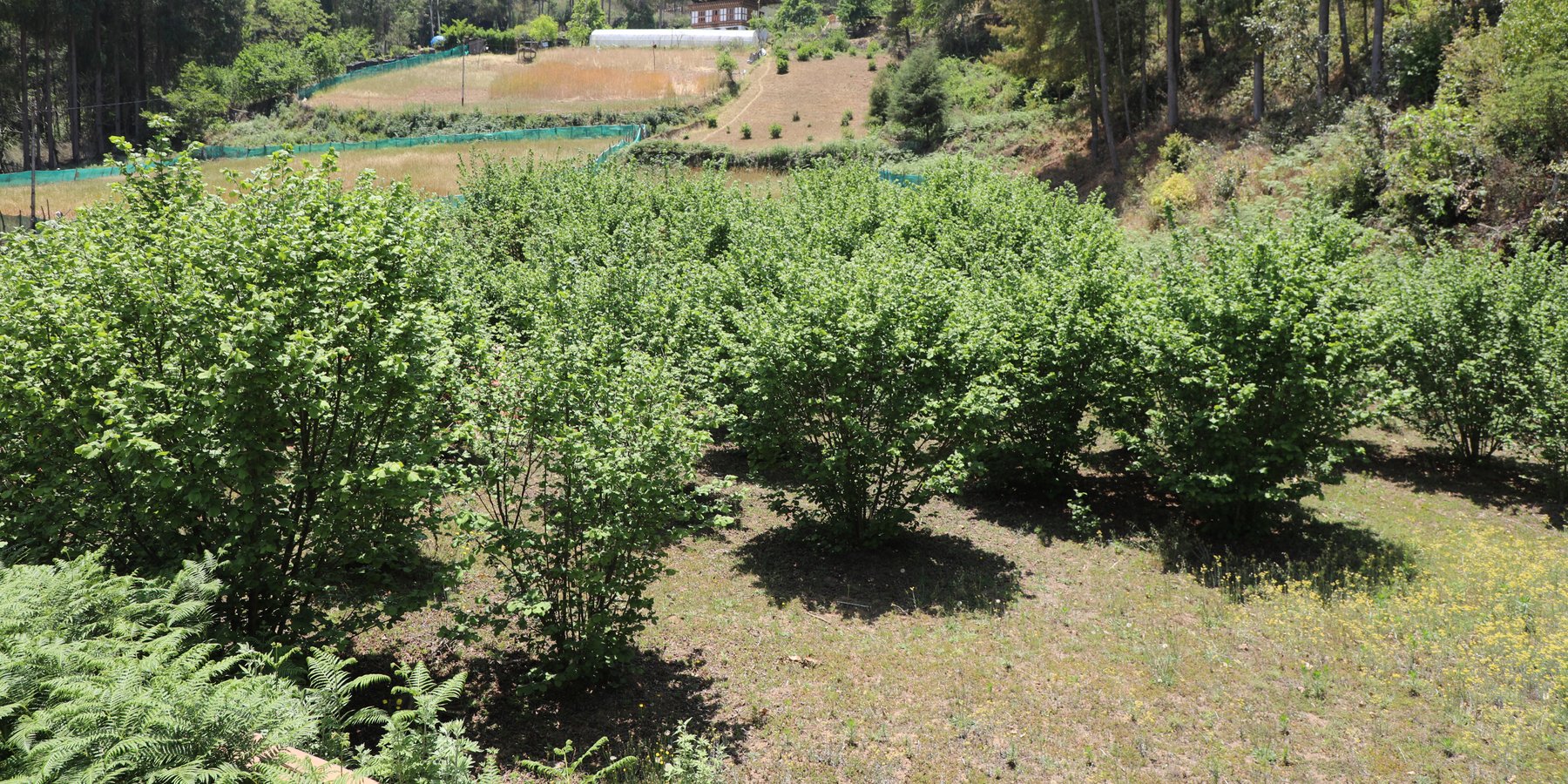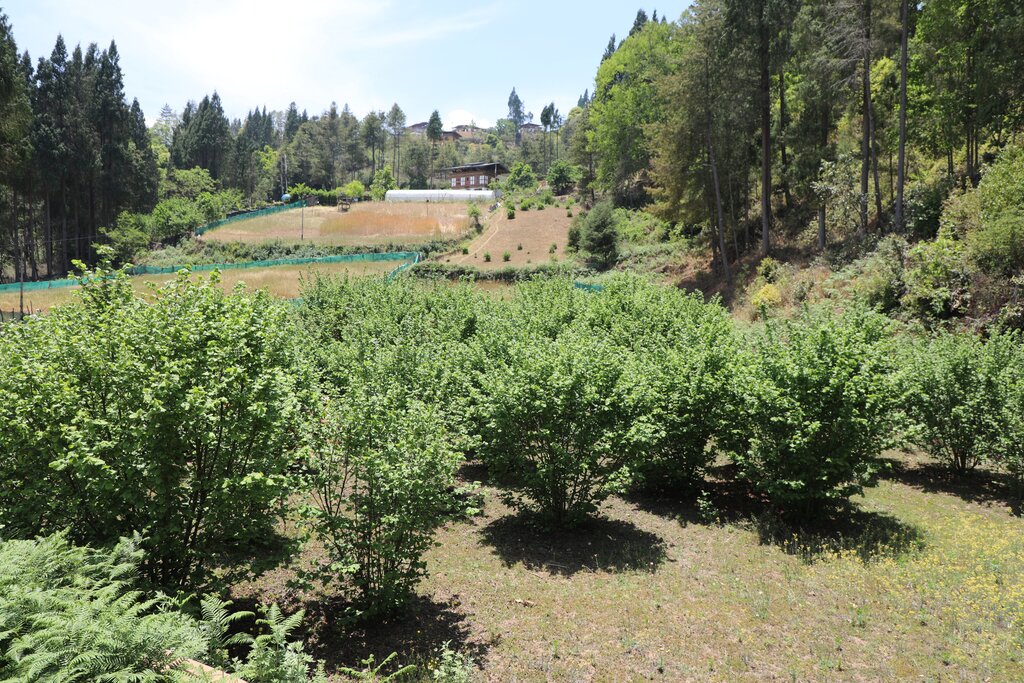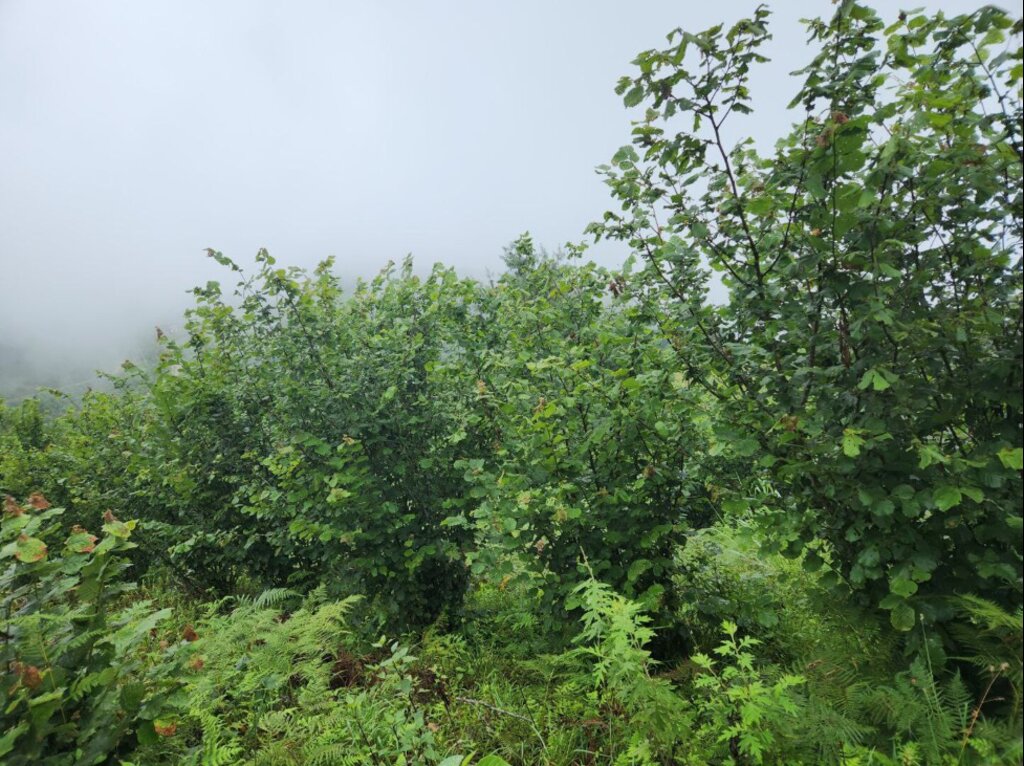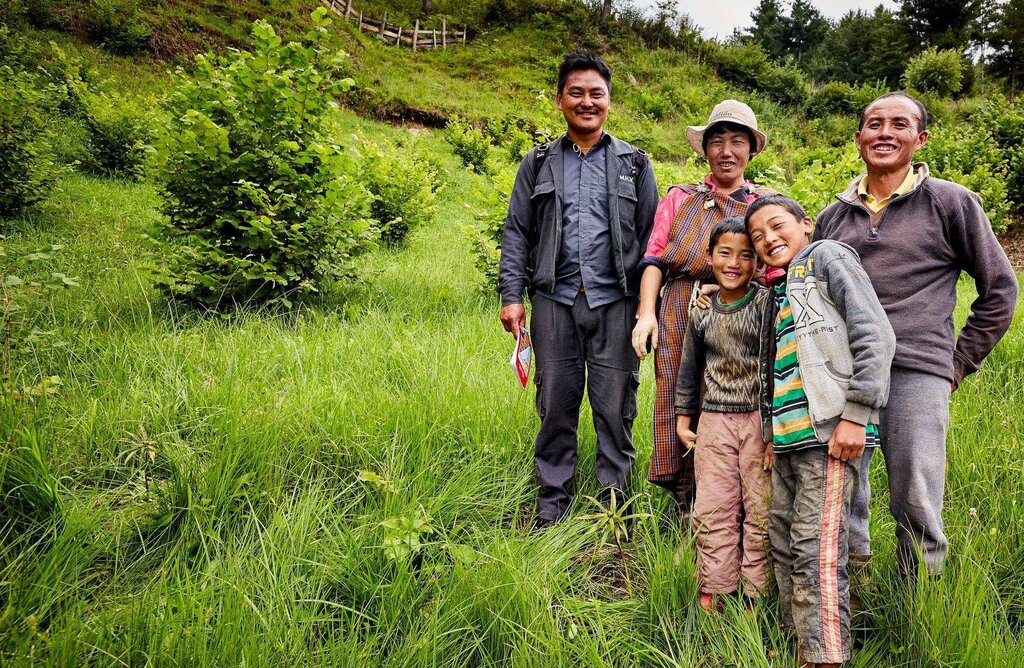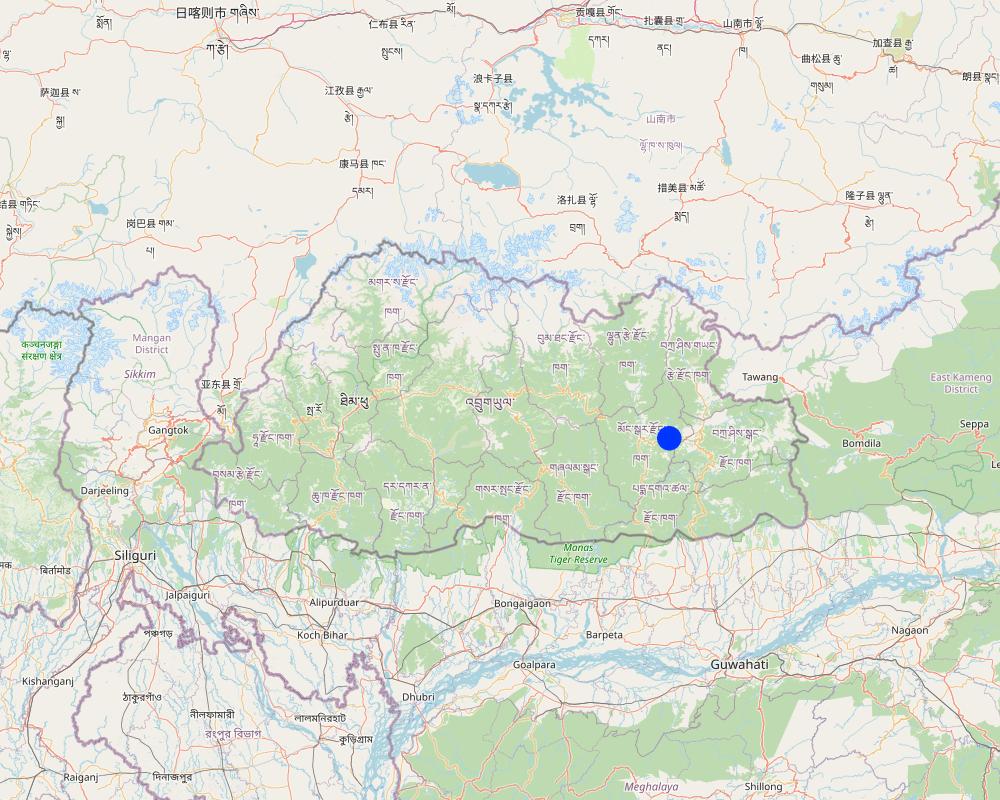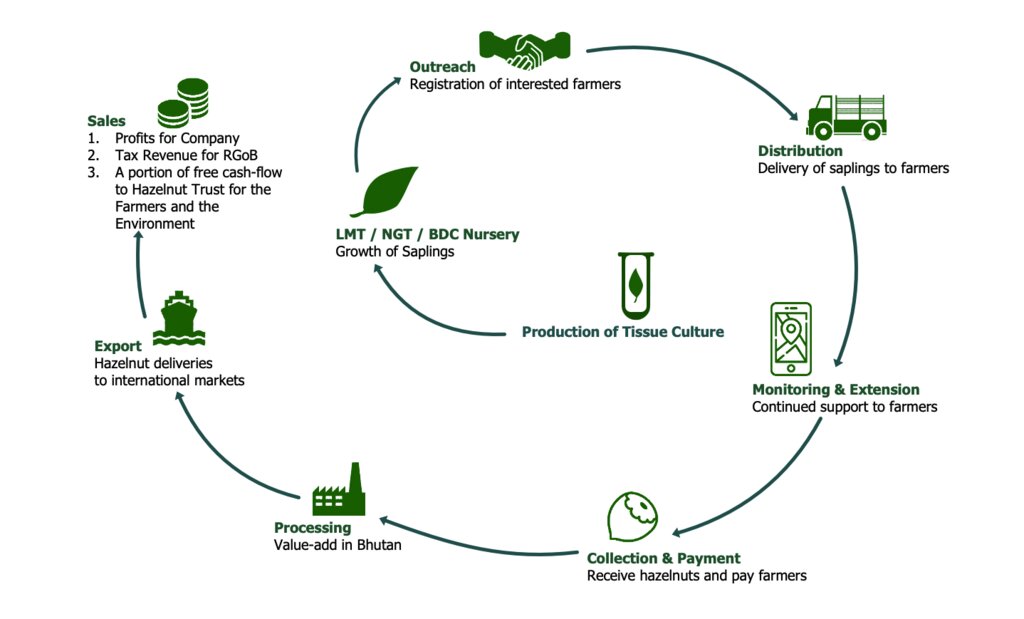Public-Private-Community Partnership for Land Degradation Neutrality [Bhutan]
- Creation:
- Update:
- Compiler: ONGPO LEPCHA
- Editor: Kuenzang Nima
- Reviewers: William Critchley, Rima Mekdaschi Studer
གཞུང་སྒེར་དམང་གསུམ་མཐུན་འགྲེལ་ཐོག་ས་ཆ་མར་ཉམས་བཀག་འཛིན།
approaches_6843 - Bhutan
View sections
Expand all Collapse all1. General information
1.2 Contact details of resource persons and institutions involved in the assessment and documentation of the Approach
Key resource person(s)
land user:
Tenzin Karma
+975 77675442
Domlung village
Domlung village, Ngatshang gewog (block), Mongar Dzongkhag (district), Bhutan
Bhutan
land user:
Penjor Tshewang
+97517544223
Domlung village
Domlung village, Ngatshang gewog (block), Mongar Dzongkhag (district), Bhutan
Bhutan
land user:
Wangmo Yeshey
+97517680522
Domlung village
Domlung village, Ngatshang gewog (block), Mongar Dzongkhag (district), Bhutan
Bhutan
land user:
Lhamo Ngawang
Domlung village
Domlung village, Ngatshang gewog (block), Mongar Dzongkhag (district), Bhutan
Bhutan
1.3 Conditions regarding the use of data documented through WOCAT
When were the data compiled (in the field)?
13/07/2023
The compiler and key resource person(s) accept the conditions regarding the use of data documented through WOCAT:
Yes
2. Description of the SLM Approach
2.1 Short description of the Approach
The public-private-community partnerships (PPCP) approach is a synergistically operational model that is used to achieve sustainable development in which the three parties jointly develop a business unit/service of mutual benefit and provide maximum benefit to the wider community. This approach is designed to enable economically disabled households and community organizations to generate long-term benefits through sustainable agriculture - in this case hazelnut production.
2.2 Detailed description of the Approach
Detailed description of the Approach:
The Mountain Hazelnut Venture (MHV) is a social enterprise established as a Public-Private-Community Partnership (PPCP) between the people and the Royal Government of Bhutan and a private company. The PPCP approach involves private entity funding of a project, and it has become common countrywide, The MHV has enabled a large-scale Foreign Direct Investment (FDI) project. The MHV provides hazelnut trees, agricultural inputs, and technical assistance to smallholder farmers. At harvest, the company purchases hazelnuts from partner growers, which are then processed for international export. The primary objective of this approach is to foster collaboration between the private company and the community to generate long-term income and revitalize vulnerable communities through sustainable agriculture. Hazelnut orchards stabilize mountain slopes, reduce soil erosion, improve water retention, and help adapt to, and mitigate, climate change by improving ground cover, retaining soil moisture and sequestering carbon.
The private company looks for interested farmers who are then registered. The company propagates good quality hazelnut seedlings and distributes them. This is followed up by constant monitoring by technical staff until fruits are harvested and processed. The implementation stage includes planning, providing them with necessary agricultural inputs, and technical support through extension and monitoring. Once the fruits are harvested, payment is made to the farmers. Implementation involves the MHV engaging with community members alongside agricultural extension agents to present and convince them about the benefits of the project. Additionally, the MHV provides training, workshops, and ongoing support. They finance the project while also taking on the role of monitoring and evaluating its outcomes.
There are three key stakeholders involved in this approach. They are the community members (landowners), the Royal Government of Bhutan, and the Mountain Hazelnut company. It is reported that there are more than 8,000 smallholder land users registered with MHV from 19 of 20 districts in Bhutan. The roles of the land users are to grow hazelnuts through nurturing the seedlings, harvesting the nuts, and selling them to the Hazelnut company as per the mutual agreement. Land users are provided free seedlings, consistent technical and field support, and the guaranteed buyback of nuts by the company. They also received training and assistance. The second key stakeholder is the Royal Government, who provides clearance and facilitates the establishment of business in line with the national Foreign Direct Investment (FDI) Policy. In the field, agriculture extension agents represent the government by facilitating communication between the hazelnut company and the communities. Lastly, the MHV as a private company is committed to fostering the development of entrepreneurs in the agribusiness sector across Bhutan.
The advantages of the approach to the land users are the financial, technical and material support provided by the private company. The land users can also develop their skills and knowledge through training on hazelnut cultivation and good agricultural practices (GAP). Hazelnut is a new crop in the locality.
Finally, the company is committed to generating income and improving the livelihood of rural communities in Bhutan. However, despite the noble objectives, the company has failed to realize its intended target, and this is an increasing cause of concern. Furthermore, there are complaints that the harvests have been poor – or even zero in some cases. It is clear that there had been inadequate investigation into the viability of hazelnuts in Bhutan. While failing on the economic front so far, from the land degradation neutrality (LDN) point of view, the hazelnut plantations have improved ground cover immensely thereby generating environmental benefits through stabilization of vulnerable agricultural land, reduction in land degradation and carbon sequestration.
2.3 Photos of the Approach
2.5 Country/ region/ locations where the Approach has been applied
Country:
Bhutan
Region/ State/ Province:
Mongar Dzongkhag
Further specification of location:
Domlung village, Ngatshang gewog
Map
×2.6 Dates of initiation and termination of the Approach
Indicate year of initiation:
2011
Comments:
The approach is currently in the monitoring and evaluation phase since the Hazelnut trees in Domlung village have not fruited even once as like most other orchards in the country.
2.7 Type of Approach
- project/ programme based
2.8 Main aims/ objectives of the Approach
The primary objective of this approach is to persuade the community to embrace the Mountain Hazelnut Venture and foster collaboration between the private company and the community to advance the project, generate long-term income, revitalise vulnerable communities through sustainable agriculture, stabilising mountain slopes, reducing erosion, improving water retention, and mitigating climate change by improving soil fertility and carbon sequestration.
2.9 Conditions enabling or hindering implementation of the Technology/ Technologies applied under the Approach
social/ cultural/ religious norms and values
- enabling
Because land users are from same ethnic group, they shared similar culture and traditional. There were no objection from other land users on implementing the technology.
availability/ access to financial resources and services
- enabling
The project is fully funded by a private company, meaning the company provides all the planting materials and inputs with regard to it; very minimal cost goes into the project by the land users.
collaboration/ coordination of actors
- enabling
Officials from the private company often visit the community to monitor and evaluate the progress of the project, and has played a significant role in providing the community members with all the skills and knowledge with regard to hazelnut cultivation.
knowledge about SLM, access to technical support
- enabling
The land users were trained on good agricultural practices (GAP) for hazelnut cultivation and proper land management practices before implementing the project.
markets (to purchase inputs, sell products) and prices
- hindering
Despite the guaranteed buyback by the company, the land users could not harvets any hazelnuts as there is no fruiting yet.
workload, availability of manpower
- enabling
Hazelnuts are fairly easy to grow and not much care is required. Hence not much of labour is required.
3. Participation and roles of stakeholders involved
3.1 Stakeholders involved in the Approach and their roles
- local land users/ local communities
Domlung community members (land users)
The roles of the Interested land users are to grow hazelnut saplings on their land, nurture these seedlings, harvest the nuts, and sell them to the Hazelnut company.
- private sector
Mountain Hazelnut Venture
It is committed to fostering the development of entrepreneurs in the agribusiness sector across Bhutan. It provides farmers with seedlings, and agricultural inputs such as fertilizers and extension services, and also buys the nuts from the land users. Apart from this Mountain Hazelnuts is committed to fostering the development of entrepreneurs in the agribusiness sector across Bhutan.
- national government (planners, decision-makers)
Ministry of Agriculture and Livestock of the Royal Government of Bhutan
Provided clearance and facilitaed business establishment as per the Foreign Direct Investment (FDI) Policy.
- Extension agent
Ngatshang gewog (block) Agriculture Extension Agent
Facilitated communication between the private company and the communities.
3.2 Involvement of local land users/ local communities in the different phases of the Approach
| Involvement of local land users/ local communities | Specify who was involved and describe activities | |
|---|---|---|
| initiation/ motivation | interactive | The land users were sensitized on the Mountain Hazelnut Venture, in particular the long term benefits of improving income and livelihoods. Mutual agreements were signed between the company and the land users. |
| planning | passive | The private company (MHV) decide on the timeline of the project and how to implement it. However, the community members and the extension agents are informed about the plan. |
| implementation | self-mobilization | For the implementation, land users were equipped with all the skills and materials required for the projects success. They plant and cultivate the hazelnut in their fields on their own, with some assistance from the company's field coordinator. |
| monitoring/ evaluation | interactive | Officials from the company (MHV) visits the land users field together with the land users, where the hazelnuts were cultivated and checks the progress of the project. |
3.3 Flow chart (if available)
Description:
The flow chart of the approach was adopted from Mountain Hazelnut Venture (MHV) website
Author:
Mountain Hazelnut Venture website (https://www.mountainhazelnuts.com/)
3.4 Decision-making on the selection of SLM Technology/ Technologies
Were decisions on the selection of the Technology(ies) made:
- Private sector (MHV)
Explain:
The decision to implement the project in Domlung was done by the private company (MHV) based on their findings and agreement by the community.
Specify on what basis decisions were made:
- evaluation of well-documented SLM knowledge (evidence-based decision-making)
4. Technical support, capacity building, and knowledge management
4.1 Capacity building/ training
Was training provided to land users/ other stakeholders?
Yes
Specify who was trained:
- land users
Form of training:
- farmer-to-farmer
- demonstration areas
- public meetings
Subjects covered:
The subjects covered included the cultivation of hazelnuts, good agricultural practices, proper land and agronomic management of hazelnuts, grafting, weed control, and sustainable land management.
Comments:
The capacity building was financed by the private company and was supervised by the agricultural extension agent.
4.2 Advisory service
Do land users have access to an advisory service?
Yes
Specify whether advisory service is provided:
- on land users' fields
- Private company
Describe/ comments:
Advisory services were provided by the field coordinator and other officials from the private company (MHV).
4.3 Institution strengthening (organizational development)
Have institutions been established or strengthened through the Approach?
- no
4.4 Monitoring and evaluation
Is monitoring and evaluation part of the Approach?
Yes
Comments:
In accordance with the land users of Domlung, officials from the private company visits the village sporadically to check the progress of the project.
If yes, is this documentation intended to be used for monitoring and evaluation?
No
4.5 Research
Was research part of the Approach?
No
5. Financing and external material support
5.1 Annual budget for the SLM component of the Approach
Indicate the annual budget for the SLM component of the Approach in US$:
30000000.00
Comments (e.g. main sources of funding/ major donors):
Mountain Hazelnut Venture (The annual budget is the total investment of the company for the entire project)
5.2 Financial/ material support provided to land users
Did land users receive financial/ material support for implementing the Technology/ Technologies?
Yes
If yes, specify type(s) of support, conditions, and provider(s):
The financial support was received in the form of planting materials and other materials such as fencing.
5.3 Subsidies for specific inputs (including labour)
- equipment
| Specify which inputs were subsidised | To which extent | Specify subsidies |
|---|---|---|
| Nets | fully financed | Green nets |
- agricultural
| Specify which inputs were subsidised | To which extent | Specify subsidies |
|---|---|---|
| seeds | fully financed | Hazelnut saplings were provided to the land users for free of cost. |
| fertilizers | partly financed | Fertilizers are bought at 50% of its original price by the land users. |
If labour by land users was a substantial input, was it:
- rewarded with other material support
5.4 Credit
Was credit provided under the Approach for SLM activities?
No
5.5 Other incentives or instruments
Were other incentives or instruments used to promote implementation of SLM Technologies?
No
6. Impact analysis and concluding statements
6.1 Impacts of the Approach
Did the Approach help land users to implement and maintain SLM Technologies?
- No
- Yes, little
- Yes, moderately
- Yes, greatly
Almost all the farming households in Domlung have cultivated hazelnuts. They were trained on how to manage land and they also reported the benefits of growing trees besides harvesting the nuts.
Did the Approach mobilize/ improve access to financial resources for SLM implementation?
- No
- Yes, little
- Yes, moderately
- Yes, greatly
There was no improvement in access to financial resources, but the land users have been supported financially for the project through provisin of inputs either free or on cost sharing basis.
Did the Approach improve knowledge and capacities of land users to implement SLM?
- No
- Yes, little
- Yes, moderately
- Yes, greatly
All the land users in Domlung village have attended several trainings and workshops before the project implementation. Some of this training included SLM intervention topics like Terrace making, stone bund walls, and growing hazelnuts in erosion-prone areas.
Did the Approach build/ strengthen institutions, collaboration between stakeholders?
- No
- Yes, little
- Yes, moderately
- Yes, greatly
The approach involves three main stakeholders i.e., land users, extension officers of the Royal Government and the private company. The approach has strengthened collaboration between stakeholders, i.e., land users and extension, extension and private company, etc.
Did the Approach empower socially and economically disadvantaged groups?
- No
- Yes, little
- Yes, moderately
- Yes, greatly
All the land users were engaged as stakeholders and were equally benefited.
Did the Approach improve gender equality and empower women and girls?
- No
- Yes, little
- Yes, moderately
- Yes, greatly
The approach allowed both men and women to participate. Thus gender equality was well taken care. It is also one of the company's objectives to ensure that women comprise approximately half of MH staff at all levels, from community lead growers through the executive team.
Did the Approach encourage young people/ the next generation of land users to engage in SLM?
- No
- Yes, little
- Yes, moderately
- Yes, greatly
Young land users of the community were the ones who showed more interest to the project.
Did the Approach lead to improved food security/ improved nutrition?
- No
- Yes, little
- Yes, moderately
- Yes, greatly
Although the land was cleared for planting hazelnuts, there were problems with pollination and variety resulting no fruiting. As a result land users turned hopeless without any income.
Did the Approach improve access to markets?
- No
- Yes, little
- Yes, moderately
- Yes, greatly
Access to the market was assured through the project. However, there was no nut production.
Did the Approach improve the capacity of the land users to adapt to climate changes/ extremes and mitigate climate related disasters?
- No
- Yes, little
- Yes, moderately
- Yes, greatly
Hazelnut plantation improved ground cover thereby enabling carbon sequestration and soil organic matter.
Did the Approach lead to employment, income opportunities?
- No
- Yes, little
- Yes, moderately
- Yes, greatly
Individuals from outside the community were able to work for the private company in the last few years.
Contribution ot Land Degradation Neutrality (LDN):
- No
- Yes, little
- Yes, moderately
- Yes, greatly
Although the MHV project failed to fully realize its main economic objective of income generation, the hazelnut plantation did improve ground cover and helped avoid, reduce and restore degraded land. It thus contributed towards achieveing voluntary Land Degradation Target (LDN) target set by the Royal Government of Bhutan.
6.2 Main motivation of land users to implement SLM
- increased production
The main motivation was to increase the production by growing hazelnut in marginal land. However, due to pollination and variety issues there was no production.
- increased profit(ability), improved cost-benefit-ratio
With assured market, the company's main objective was to enable sustainable source of income for farmer and increase profitability. Even during the implementation process most of the costs were borne by the project thus giving less financial burden to the land users.
- reduced land degradation
Although the land users did not see direct relation between hazelnut plantation and land degradation, after the training provided by the company, they did realize that the hazelnut plantation can help reduce land degradation through improved ground cover.
- reduced workload
Hazelnuts are hardy plants (adaptable) and fairly easy to grow and manage as compared to other economic crops like vegetables and cereals. This gives some leisure time to the land users.
- enhanced SLM knowledge and skills
Before Hazelnuts plantation, land remained barren and exposed to different factors of land degradation. However, with hazelnut plantation, the lands are covered from direct sun and rain thereby preventing land degradation. Many land users shared that they didn't have this idea/knowledge before.
6.3 Sustainability of Approach activities
Can the land users sustain what has been implemented through the Approach (without external support)?
- no
If no or uncertain, specify and comment:
The land users who agreed to grow hazelnuts were the ones who were economically disabled. They could have sustained what was implemented through the approach if everything had gone as planned. However, there has been almost zero production of the hazelnuts from almost all hazelnut growing areas which has seriously affected the income. It has been almost 12 years since the first implementation of the project. Land users mentioned that they are now looking for other alternatives so that they can uproot hazelnuts and replace them with some other productive crop.
6.4 Strengths/ advantages of the Approach
| Strengths/ advantages/ opportunities in the land user’s view |
|---|
| Support from the company: Easy for the land users to implement the project due to material and technical supports from the approach. Land users received inputs like hazelnut seedlings at the beginning, which was for free. They also received support for growing the seedlings, Taking care of the seedlings, etc., |
| Assured market: Land users also mentioned that the main motivation to get involved in such an approach was the market and the possibility of generating income. The company was willing to buy whatever quantity of hazelnuts they could produce from their land. |
| Capacity development: In addition to the support (agricultural inputs), the land users also received various training through which they were exposed to other technologies which some of them were totally unaware. They could enhance their skills and knowledge on hazelnut production like orchard cultivation, hazelnut value-chain, including processing and the provision of goods and services. |
| Strengths/ advantages/ opportunities in the compiler’s or other key resource person’s view |
|---|
| Opportunities to economically disabled land users: One of the primary objectives of Mountain Hazelnut Venture is to enable smallholder farming households to generate long-term income, revitalize vulnerable communities through sustainable agriculture. Through this approach many youths were given employment as a worker in the project sites. |
| Focus on sustainable land management: The approach made land uesres to grow hazelnuts sapling in their marginal or unproductive land. When hazelnuts is fully grown, hazelnut plantations stabilize mountain slopes, reduce soil erosion, improve water retention, and mitigate climate change by improving soil fertility and carbon sequestration. In brief, hazelnut plantation as a SLM intervention, contributes to the realization of the land degradation neutrality (LDN) target and adapt to and mitigate climate change. |
6.5 Weaknesses/ disadvantages of the Approach and ways of overcoming them
| Weaknesses/ disadvantages/ risks in the land user’s view | How can they be overcome? |
|---|---|
| No transparency of the information: Land users shared that they were lured by some officals saying the approach to be very profitable. They didn't explained them very well on positive and negative long term impact of the project. They didnt know about the plant (hazelnuts), Its problem in fruiting, etc., | This type of project is maily implemented for the welfare of the community. It should never be implemented for sole benefit of the company. |
| Weaknesses/ disadvantages/ risks in the compiler’s or other key resource person’s view | How can they be overcome? |
|---|---|
| No proper planning and research: The main reason why this hazelnut planations failed in many places in Bhutan could be due to lack of proper planning and research. Given the wide range of elevation and climatic conditions in Bhutan, more adaptability or suitability trials at different elevations could have been conducted. | Suitability trials of different varieties of hazelnuts could have been done so that the best performing varieties and management practices could have been promoted to the land users on large scale. |
| No risk management: It appears like the MHV initiated its business with full confidnce that the project will do well in Bhutan and as such no risk management plans were in place. For instance, land users sacrificed most of their land with the hope of generating good income, but this didn't happen in reality. Many land users were left devasted and hopeless without any compensation from the company. | Any project should account the risk and accordingly provision risk management plan in the proposal and agreement. Such provisions should also be made transparent to all the parties so that it becomes very clear about the compensation should the project fail. |
7. References and links
7.1 Methods/ sources of information
- field visits, field surveys
One household
- interviews with land users
Four individuals
7.2 References to available publications
Title, author, year, ISBN:
Asian Development Bank. (n.d.). Public-Private Partnership Handbook. ADB.
Available from where? Costs?
https://www.adb.org/sites/default/files/institutional-document/31484/public-private-partnership.pdf
Title, author, year, ISBN:
Perez, M. C. (2015). Public-Private-Community-Partnerships for Renewable Energy Cooperatives. Wegeningen UR.
Available from where? Costs?
https://edepot.wur.nl/337095
7.3 Links to relevant information which is available online
Title/ description:
Mountain Hazelnut Venture
URL:
https://www.mountainhazelnuts.com/
Title/ description:
Public–Private–Community Partnership
URL:
https://penabulufoundation.org/en/public-private-community-partnership/
Links and modules
Expand all Collapse allLinks
No links
Modules
No modules


